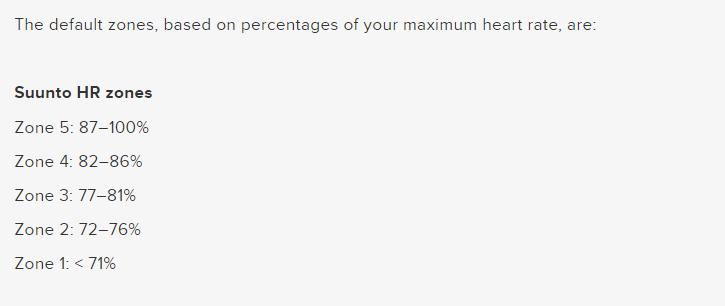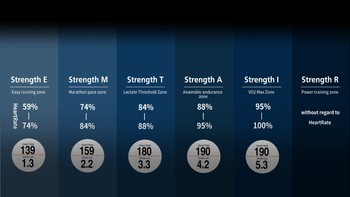HR Zones in the watch and suunto app
-
@hanta not at all to be honest. If it is I’ll make a plan and include the users here
-
Hi, a slightly different question in this context (I did not want to open a new topic in addition):
In the Suunto 5, the default for the HR zones is given in a completely different way than in the classic specifications such as 90-80-70% x HRmax.- Why are the recommendations of Suunto 5 so different?
- What values for the HR zones should I prefer as a recreational athlete - Suunto’s recommendations or the values given in the fitness literature?
Thanks for your tips!
-
@Armin-S said in HR Zones in the watch and suunto app:
Hi, a slightly different question in this context (I did not want to open a new topic in addition):
In the Suunto 5, the default for the HR zones is given in a completely different way than in the classic specifications such as 90-80-70% x HRmax.- Why are the recommendations of Suunto 5 so different?
- What values for the HR zones should I prefer as a recreational athlete - Suunto’s recommendations or the values given in the fitness literature?
Thanks for your tips!
Does anyone here have an explanation or suggestion?
-
@Armin-S This is a very tough question. The best way to set HR zones is to get a lactate threshold test done. In most places these are not that expensive. Otherwise you can estimate from your maximum and adjust based on RPE. I frankly do not know how the S5 guesses HR zones as I input mine manually.
-
Perhaps I can help here.
For running this was suggested for me and what I suggest to others
I5 92-97%
I4 87-92%
I3 82-87%
I2 72-82%
I1 60-72% -
I had the same question for Suunto’s default HR zones as well, it’s not just 10% 10%, it’s not HRR either.
I did a lab test to find my VO2max and the doctor told me the Lactate threshold is not been used anymore for 10 years in France, it’s too old fashion and it worth nothing for nowadays, they do a Ventilatory threshold test which can find you a VT1 and VT2 (your lactate threshold is in this zone), it’s the best zone that you can work on.
-
@Dimitrios-Kanellopoulos said in HR Zones in the watch and suunto app:
Perhaps I can help here.
For running this was suggested for me and what I suggest to others
I5 92-97%
I4 87-92%
I3 82-87%
I2 72-82%
I1 60-72%Hello DK, it’s the predefined zones in Suunto watches? or it’s just YOUR suggestions?
-
@zhang965 my suggestions. I need to find the source 1 sec
-
-
I think the question was, we wanted to know where this definition comes from, it seems it’s different than others references, it most likes only suunto’s definition
-
@zhang965 said in HR Zones in the watch and suunto app:
I had the same question as Suunto’s default HR zones as well, it’s not just 10% 10%, it’s not HRR either.
I did a lab test to find my VO2max and the doctor told me the Lactate threshold is not been used anymore for 10 years in France, it’s too old fashion and it worth nothing for nowadays, they do a Ventilatory threshold test which can find you a VT1 and VT2 (your lactate threshold is in this zone), it’s the best zone that you can work on.
I disagree with the fact that LT is worth nothing but combining with VO2 max is best. When pyruvate produced by glycolysis cannot be utilized in the TCA cycle lactate accumulates and the pH can drop due to hydrogen ion production. The ability to use lactate and prevent its accumulation will vary depending on the type of muscle fibers where endurance athletes will have a much higher number of slow twitch fibers and sprinters, fast twitch fibers. The lactate threshold will change depending on fitness as well.
-
@zhang965 said in HR Zones in the watch and suunto app:

Thanks for the link. Exactly this information I was looking for! Very nice that there is this help here in the forum. Thanks again

-
@Brad_Olwin said in HR Zones in the watch and suunto app:
@zhang965 said in HR Zones in the watch and suunto app:
I had the same question as Suunto’s default HR zones as well, it’s not just 10% 10%, it’s not HRR either.
I did a lab test to find my VO2max and the doctor told me the Lactate threshold is not been used anymore for 10 years in France, it’s too old fashion and it worth nothing for nowadays, they do a Ventilatory threshold test which can find you a VT1 and VT2 (your lactate threshold is in this zone), it’s the best zone that you can work on.
I disagree with the fact that LT is worth nothing but combining with VO2 max is best. When pyruvate produced by glycolysis cannot be utilized in the TCA cycle lactate accumulates and the pH can drop due to hydrogen ion production. The ability to use lactate and prevent its accumulation will vary depending on the type of muscle fibers where endurance athletes will have a much higher number of slow twitch fibers and sprinters, fast twitch fibers. The lactate threshold will change depending on fitness as well.
OK, then do a lactate threshold test
-
@Dimitrios-Kanellopoulos said in HR Zones in the watch and suunto app:
@zhang965 my suggestions. I need to find the source 1 sec
I show you an example from euh… GARMIN!
It’s funny because… this piece of information only can be found in Garmin TW/HK, it quite closes to suunto’s proposal.


-
@Dimitrios-Kanellopoulos said in HR Zones in the watch and suunto app:
@zhang965 my suggestions. I need to find the source 1 sec
it’s…33 minutes ago

-
@zhang965 lol yeah.
My coach :
They relate to how humans produce lactate at different intensity and are a general guideline until you have a dedicated lactate threshold test and vo2max test to guide you. The irony is that after you have those test 99% of athletes still fall into the zones I have you. Just with small variations of course.
To fully understand the concept you’d have to analyze how different elite athletes perform. Most top athletes ; with almost no exemption, clock in their individual lactate threshold at 91-95% of max hr.
-
Out of curiosity, who is using real HRmax (lab tested) and who is using “calculated” one ?
For those who use calculated, are you using Cooper’s algorithm or something more “recent” like Tanaka and maybe Karvonen to retrieve HR for specific percentage ? -
@sartoric I have lab tested when getting also LTHR. Karvonen would have sent my HRmax to 168 but I have 193

-
I set the lab tested HR on my watch.
-
@sartoric said in HR Zones in the watch and suunto app:
Out of curiosity, who is using real HRmax (lab tested) and who is using “calculated” one ?
For those who use calculated, are you using Cooper’s algorithm or something more “recent” like Tanaka and maybe Karvonen to retrieve HR for specific percentage ?I run and climb as fast as possible, and just before dying, I set my watch and pray to recover.
